| Author |
Message |
Craig Peters

|
 Posted: Sun 11 Jun, 2006 2:17 pm Post subject: Wire Grip Swords Posted: Sun 11 Jun, 2006 2:17 pm Post subject: Wire Grip Swords |
 |
|
|
I was wondering: what is the oldest sword that we know of where we can say with a reasonable degree of certainty that it was originally made with a wire wrap grip, rather than having one later added?
|
|
  |
 |
Chad Arnow
myArmoury Team


|
 Posted: Sun 11 Jun, 2006 2:49 pm Post subject: Re: Wire Grip Swords Posted: Sun 11 Jun, 2006 2:49 pm Post subject: Re: Wire Grip Swords |
 |
|
| Craig Peters wrote: | | I was wondering: what is the oldest sword that we know of where we can say with a reasonable degree of certainty that it was originally made with a wire wrap grip, rather than having one later added? |
The sword from the Toledo Cathedral dated before 1319 has a grip bound with a single strand of twisted silver wire.
Can Grande della Scala's sword dates to before his death and was sealed in his tomb in 1329. The grip is "wood bound with fine silver wire with an overbinding of green silk cord."
There may be others that are older of course. Those are about the earliest I could find with a quick gland through Oakeshott's Records of the Medieval Sword.

ChadA
http://chadarnow.com/
|
|
    |
 |
Jared Smith

|
 Posted: Sun 11 Jun, 2006 3:09 pm Post subject: Posted: Sun 11 Jun, 2006 3:09 pm Post subject: |
 |
|
This is going to get very tough if you want an actual surviving sword. At least greek text describing such hilts survive. There should be no doubt the correct answer is in the B.C. period.
Aegean and Myceneaen period (8 B.C.) works certainly exhibit all of the skills required, but the ones you find easily through internet searches have full gilt leaf around grips, as opposed to just alternating silver/gold wire as some descriptions would indicate was also done.
I'll keep looking through the grave shaft / Mycenean finds to see if I can turn up a surviving one.
Absence of evidence is not necessarily evidence of absence!
|
|
  |
 |
Craig Peters

|
 Posted: Sun 11 Jun, 2006 3:11 pm Post subject: Posted: Sun 11 Jun, 2006 3:11 pm Post subject: |
 |
|
|
The Sword of St Maurice of Vienna is certainly older than either of these two swords, but it seems probable to me that the wire grip is a later addition to the sword after it had been in use for some time. Out of curiousity, what leads you to believe that the two swords you mentioned did not have the silver wire added later? The fact that the wire is silver would suggest that it was the original grip made with the sword as part of the hilt furniture "decor", but then again, it could have been a later addition too.
|
|
  |
 |
Chad Arnow
myArmoury Team


|
 Posted: Sun 11 Jun, 2006 3:21 pm Post subject: Posted: Sun 11 Jun, 2006 3:21 pm Post subject: |
 |
|
| Craig Peters wrote: | | The Sword of St Maurice of Vienna is certainly older than either of these two swords, but it seems probable to me that the wire grip is a later addition to the sword after it had been in use for some time. Out of curiousity, what leads you to believe that the two swords you mentioned did not have the silver wire added later? The fact that the wire is silver would suggest that it was the original grip made with the sword as part of the hilt furniture "decor", but then again, it could have been a later addition too. |
The Vienna sword's grip is believed to be later. The Can Grande sword is obiviously still in the condition it came out of his tomb in. There have been no restorations. See below.
Oakeshott doesn't mention that the Toledo sword's grip is re-wrapped and he's usually pretty good about that. Doesn't mean it isn't, though.
 Attachment: 23.36 KB Attachment: 23.36 KB
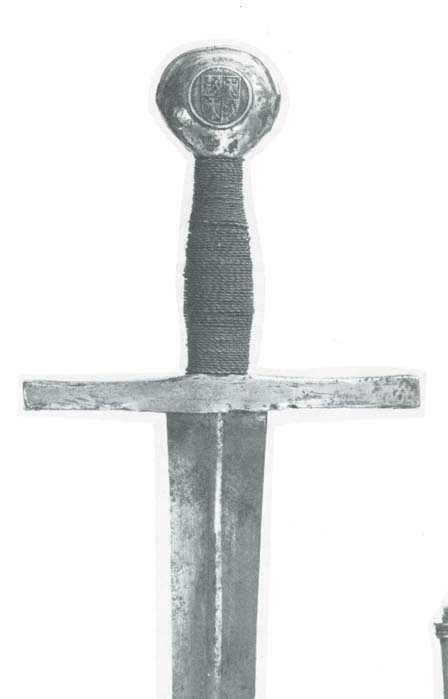
Sword from Toledo Cathedral
 Attachment: 56.52 KB Attachment: 56.52 KB
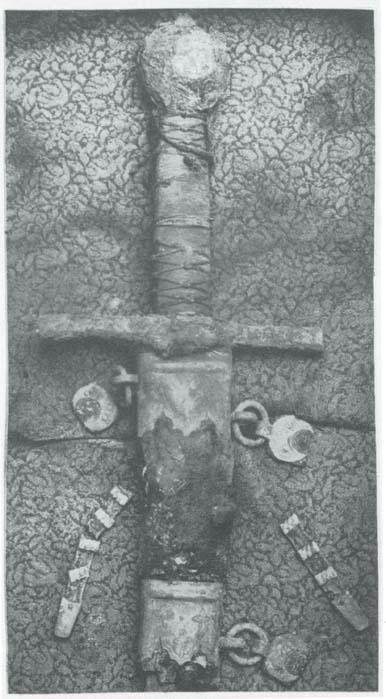
Can Grande della Scala's sword

ChadA
http://chadarnow.com/
|
|
    |
 |
Jared Smith

|
 Posted: Sun 11 Jun, 2006 3:37 pm Post subject: Posted: Sun 11 Jun, 2006 3:37 pm Post subject: |
 |
|
Kairo (National Museum) photo, 3rd millenia B.C. sword at bottom shows at least ornamental wire running through the grip.
 Attachment: 67.11 KB Attachment: 67.11 KB
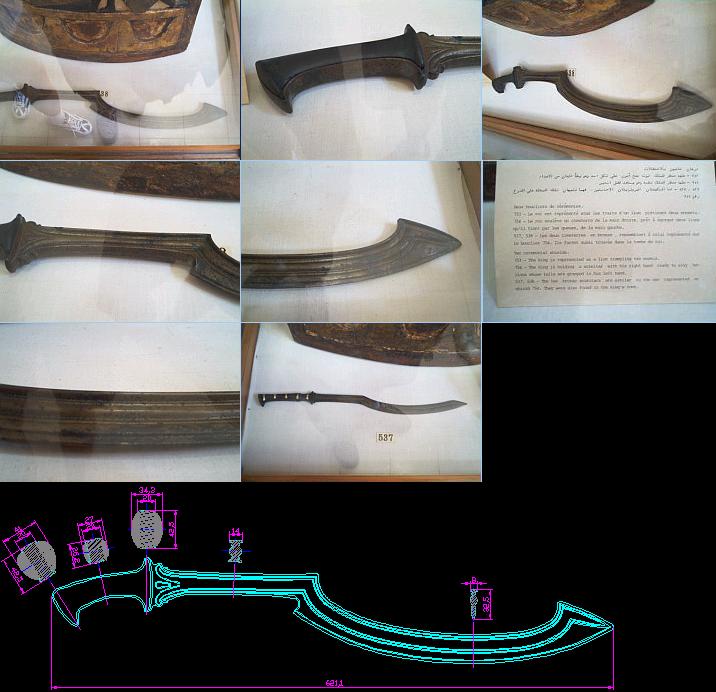
Absence of evidence is not necessarily evidence of absence!
|
|
  |
 |
|
Bill Fryman
|
 Posted: Sun 11 Jun, 2006 5:07 pm Post subject: Posted: Sun 11 Jun, 2006 5:07 pm Post subject: |
 |
|
|
So that blade is ~5000 years old? Thats amazing how well it stood up, even considering the dry climate.
|
|
  |
 |
|
C.L. Miller
|
 Posted: Sun 11 Jun, 2006 5:08 pm Post subject: Posted: Sun 11 Jun, 2006 5:08 pm Post subject: |
 |
|
There are a few surviving swords and sword fragments with wire wrapped grips dating from the viking age. Some of these are suspicious in that they feature only a small amount of wire wrapped directly around the tang. Such wraps could be the result of misinterpretation or embelishment, the small amount of wire could have been decorative, or a portion of the wrap may have been lost. Other examples more clearly illustrate a functional wire wrap, such as this fragment from Geibig. Unfortunately, given the state of the find, only a very general date of 800-1000 CE can be assigned to it.

|
|
  |
 |
|
C.L. Miller
|
 Posted: Sun 11 Jun, 2006 5:12 pm Post subject: Posted: Sun 11 Jun, 2006 5:12 pm Post subject: |
 |
|
Kirk Lee Spencer posted this image in response to one of my queries some time ago... the grip in the lower right appears as though it may feature a wire wrap grip, but this one photo is all I have to go on. Perhaps Kirk can provide us with some additional information.
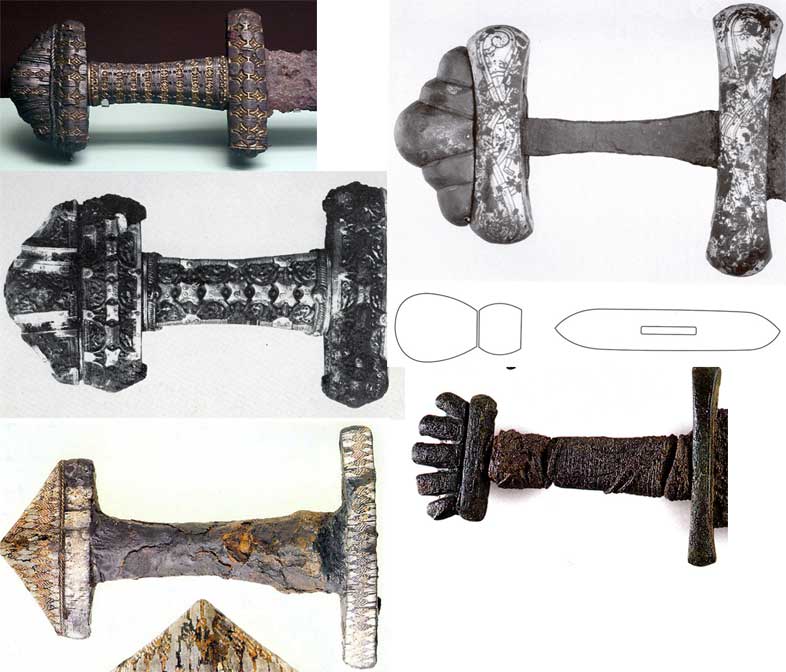
|
|
  |
 |
Craig Peters

|
 Posted: Sun 11 Jun, 2006 6:03 pm Post subject: Posted: Sun 11 Jun, 2006 6:03 pm Post subject: |
 |
|
|
So, in other words, it would appear that while quite rare, swords with wire wrap grips have existed long before the Middle Ages, but probably didn't become relatively common until the late Medieval period?
|
|
  |
 |
|
Jeremy V. Krause
|
 Posted: Sun 11 Jun, 2006 6:22 pm Post subject: Posted: Sun 11 Jun, 2006 6:22 pm Post subject: |
 |
|
|
I would say that it is difficult to make any definitive statement about the ratio of wire wrapped hilts as the vast majority of swords of the middle ages have no conserved hilts but only bare tangs. I believe that we see more wire wrapped hilts in the latter middle ages and renaissance because we have more intact hilts.
|
|
  |
 |
Jared Smith

|
 Posted: Sun 11 Jun, 2006 6:26 pm Post subject: Posted: Sun 11 Jun, 2006 6:26 pm Post subject: |
 |
|
I don't want to crash the topic or derail it from your original post. Wire production technology was not one of those things that steadily got better (like production of good steel.) It has been mastered and lost at least once. It would be surprising if this was not reflected in weapons of the elite.
The Phoenecians ability to produce wire and utilize it several thousand years ago was such that they are credited with installing braces (performing the medical technique both in South America and Europe) rivaling the quality of modern dentistry. At least three ancient cultures supoosedly produced exquisite items involving wire ornamentation. Wire grips were described in ancient epics, and a couple of viewable photographic artifacts are around. To be consistent with the idea of a dark age, I suspect that there could have been a "disappearance" of the required skill and materials somewhere around 500 B.C. to 500 A.D.
Absence of evidence is not necessarily evidence of absence!
|
|
  |
 |
|
R. D. Simpson
|
 Posted: Sun 11 Jun, 2006 8:51 pm Post subject: Posted: Sun 11 Jun, 2006 8:51 pm Post subject: |
 |
|
| Jared Smith wrote: | | To be consistent with the idea of a dark age, I suspect that there could have been a "disappearance" of the required skill and materials somewhere around 500 B.C. to 500 A.D. |
Correct me if I'm mistaken, but wasn't maille usually made from coiled wire? If so, the use of maille during the Dark Ages would seem to speak against the idea that wire-making technology had been lost in that period.
Gloria Virtutem Sequitur
|
|
  |
 |
Jared Smith

|
 Posted: Sun 11 Jun, 2006 9:40 pm Post subject: Posted: Sun 11 Jun, 2006 9:40 pm Post subject: |
 |
|
I just don't know if anybody coiled the wire for mail or not. But it was hand made iron formed into wire while being hot worked. Coiling would make more sense if it were more ductile (steel.)
Some Conquistador mail excavated in America (late 1500's stuff) was found to be made from drawn wire (all welded links too.) In general, ductile wire drawing technology is tough to find in Northern Europe before 10th century A.D. Earliest ability to draw steel (iron ferrite is really difficult, but a few cases exist where researchers contemplate that it might have been done) is not until around 1350 A.D. (maybe two examples....not sure.)
http://www.wga.hu/frames-e.html?/html/d/durer/2/16/1/02mill.html One of the earliest known steel wire draw mills in England that can be positively identified in time and location.
Even fine Byzantine work (1300 A.D. threads in fabrics, etc.) is hand hammered thread, not round extruded or rolled wire similar in quality to what was around a few thousand years ago.
Pre 1400's historic mail seems to be hand made wire. The iron could have been manually hammered (some speculate in a slotted anvil or similar tool) to produce the wire. It is not uniform as extruded wire would have been. http://www.forth-armoury.com/research/wire/authentic_wire.htm
Absence of evidence is not necessarily evidence of absence!
|
|
  |
 |
|
R. D. Simpson
|
 Posted: Sun 11 Jun, 2006 11:10 pm Post subject: Posted: Sun 11 Jun, 2006 11:10 pm Post subject: |
 |
|
| Jared Smith wrote: | I just don't know if anybody coiled the wire for mail or not. But it was hand made iron formed into wire while being hot worked. Coiling would make more sense if it were more ductile (steel.)
Some Conquistador mail excavated in America (late 1500's stuff) was found to be made from drawn wire (all welded links too.) In general, ductile wire drawing technology is tough to find in Northern Europe before 10th century A.D. Earliest ability to draw steel (iron ferrite is really difficult, but a few cases exist where researchers contemplate that it might have been done) is not until around 1350 A.D. (maybe two examples....not sure.)
http://www.wga.hu/frames-e.html?/html/d/durer/2/16/1/02mill.html One of the earliest known steel wire draw mills in England that can be positively identified in time and location.
Even fine Byzantine work (1300 A.D. threads in fabrics, etc.) is hand hammered thread, not round extruded or rolled wire similar in quality to what was around a few thousand years ago.
Pre 1400's historic mail seems to be hand made wire. The iron could have been manually hammered (some speculate in a slotted anvil or similar tool) to produce the wire. It is not uniform as extruded wire would have been. http://www.forth-armoury.com/research/wire/authentic_wire.htm |
Ah . . . I stand corrected 
Gloria Virtutem Sequitur
|
|
  |
 |
Jared Smith

|
 Posted: Mon 12 Jun, 2006 2:22 pm Post subject: Posted: Mon 12 Jun, 2006 2:22 pm Post subject: |
 |
|
Since this has sort of become a "wire disertation", I figured I would cover the bases.
I tried to find a link showing actual Roman wire geometry, but can't locate it quickly. Roman wire (often brass/bronze type alloys) was typically "knuckled" or twisted. It was definately not like smooth drawn wire that would have to have been produced through an elaborate rolling process or round hole extrusion method resulting in wire comparable to pre 1000 B.C. wire of the African continent (primarily Egyptian and Spanish distribution points...draw mill locations not identified to the best of my knowledge.)
I really am dissapointed someone has not produced a photo of an actual Roman sword with a wire grip. I have great admiration for the military organization and deep value of technologies rather imported or home grown. I just have to believe they did this classy technique.
Many organizations (including some American wire associations) mislead things a little by crediting the wire gauge system to the Romans. It is said that the Romans had fairly comparable numerical systems for sizes of wire, corresponding to the number of successively smaller holes the wire was drawn through to get small diameters. I actually am not contesting the possibility that Romans did number the sizes of wire based on such a principle. Only, I do not think there is any defensible evidence that the Romans did this work themselves. If this story is true, it would seem more likely that they based this thinking on knowledge of what was once done in Egypt and Moorish territories under their control. Also, as far as I can tell, this system of assigning numbers to wire sizes really only provably dates back to times of Gaul conquests (sort of an all time low point in terms of precision diameter wire quality.)
Absence of evidence is not necessarily evidence of absence!
|
|
  |
 |
Kirk Lee Spencer

|
 Posted: Mon 12 Jun, 2006 2:45 pm Post subject: Posted: Mon 12 Jun, 2006 2:45 pm Post subject: |
 |
|
| C.L. Miller wrote: | Kirk Lee Spencer posted this image in response to one of my queries some time ago... the grip in the lower right appears as though it may feature a wire wrap grip, but this one photo is all I have to go on. Perhaps Kirk can provide us with some additional information.
 |
Hi all...
That picture came from a general work on the Vikings entitled "VIKINGS: North Atlantic Saga" ed. William Fitzhugh and Elisabeth Ward. The book had this tantalizing picture but with no source info or data.
From the picture, it appear to be a small wood core with wire wrap.
I started this thread:
http://www.myArmoury.com/talk/viewtopic.php?t...ight=inlay
to suggest that grips "bound in silver" as per the Viking sagas, or wire wrapped grips were more common than the archeologcial record suggests... and that the wire, and maybe even easily removed wire inlay, was taken off many of the swords before they were placed in the graves. By the end of the thread I think I was arguing against myself.
If you are interested in wire grips you might be interested in it... (especially the post by PJ). It has a few nice pictures of sword finds with wire grip remains.
I have attached pictures of the Temple Church find... This is an example of the finds C.L. mentioned where the wire is wrapped around the tang and may or may not have been part of a grip.
ks
 Attachment: 76.8 KB Attachment: 76.8 KB
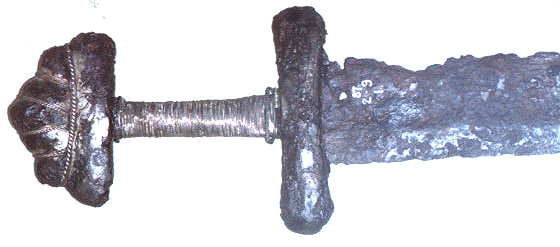
From the Thames River at Temple Church.
Now in the British Museum
 Attachment: 98.74 KB Attachment: 98.74 KB
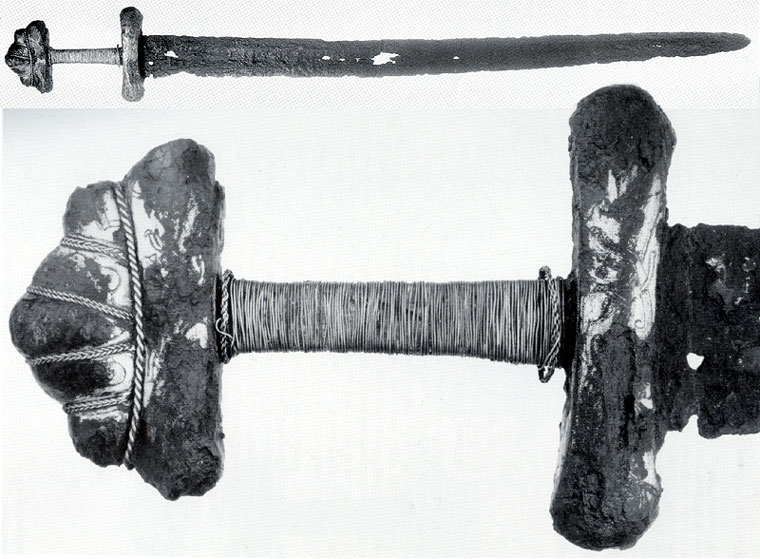
In British Museum.
Image source "Sword of the Viking Age" by Ian Peirce
Two swords
Lit in Eden’s flame
One of iron and one of ink
To place within a bloody hand
One of God or one of man
Our souls to one of
Two eternities
|
|
  |
 |
Bruno Giordan

|
 Posted: Tue 13 Jun, 2006 4:52 am Post subject: Re: Wire Grip Swords Posted: Tue 13 Jun, 2006 4:52 am Post subject: Re: Wire Grip Swords |
 |
|
| Chad Arnow wrote: | | Craig Peters wrote: | | I was wondering: what is the oldest sword that we know of where we can say with a reasonable degree of certainty that it was originally made with a wire wrap grip, rather than having one later added? |
The sword from the Toledo Cathedral dated before 1319 has a grip bound with a single strand of twisted silver wire.
Can Grande della Scala's sword dates to before his death and was sealed in his tomb in 1329. The grip is "wood bound with fine silver wire with an overbinding of green silk cord."
There may be others that are older of course. Those are about the earliest I could find with a quick gland through Oakeshott's Records of the Medieval Sword. |
The wire in cangrande's sword is plain (also it was interwoven with silk somehow)
|
|
  |
 |
|
|

